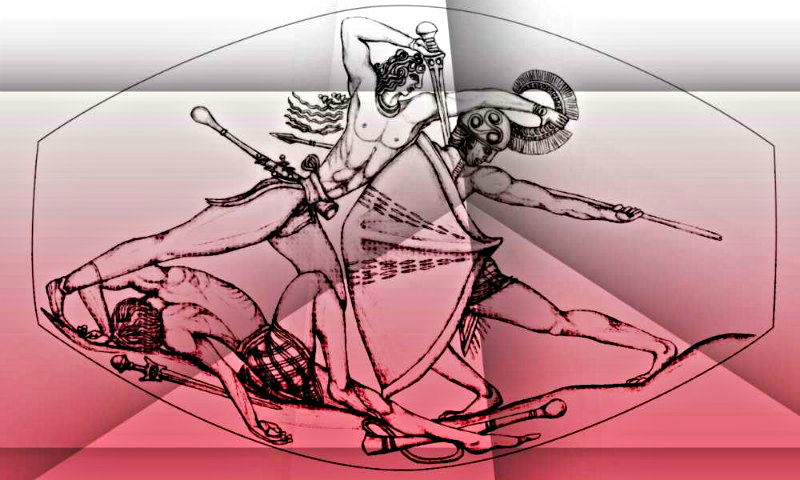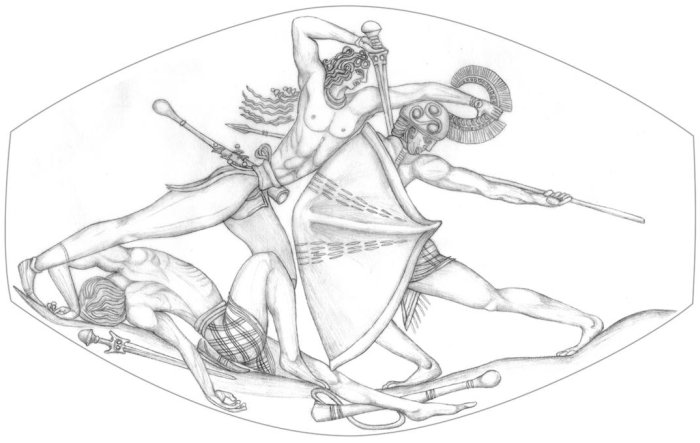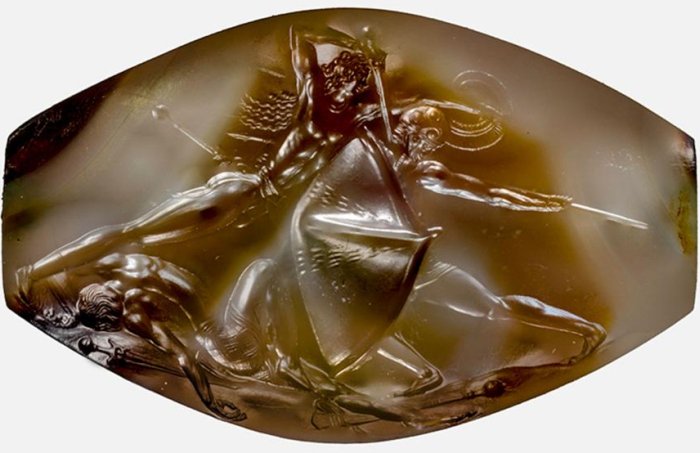Posts: 828 Location: Nykøbing Falster, Denmark
Tue 19 Sep, 2017 11:12 am
| Mark Lewis wrote: |
| Niels Just Rasmussen wrote: | | Sadly the statements given from archeologist to the journalists are often unfounded by the material finds (or the journalists simply just make it more sensationalistic). So generally when the scientific papers come forth, one can judge it more soundly. |
Actually the paper is out already, complete with the statement about the game pieces!
http://onlinelibrary.wiley.com/doi/10.1002/ajpa.23308/full |
Oh thanks Mark!
Yeah that sounds a bit unfounded to me, since they just site two papers (Hamel 1934 and Whittaker 2006) without any further explanation for that reasoning (one of the papers also being really old).
"Furthermore, a full set of gaming pieces indicates knowledge of tactics and strategy (van Hamel, 1934; Whittaker, 2006), stressing the buried individual's role as a high-ranking officer."
Problems:
Firstly: Grave goods doesn't have to belong to the deceased. It could have been deposited by a fellow "drengr" as a sign of respect or actually made specifically for the burial.
Second: The grave goods could simply indicate, that the person loved to play chess and (hnefa)-tafl/tavl. That in itself most likely indicate a high-status person, since as a warrior you have a lot of leisure time.
Yet to conclude that it specifically mean a high ranking officer with knowledge of tactics and strategy is pushing it a bit. The hird would certainly also play boardgames with their lord in the drengr-brotherhood, so a hird-member is certainly also possible. If the deceased owned the chess set it could have been a gift from the lord (or won as the result of a particular game?).
There are many possibilities for how it ended up there.She could have been what the article said, but it is not something you can conclude automatically when finding a chess set. All Scandinavian burials are different from each other (higher or lesser degree), that is basically the only element, where they are all alike.
Thirdly: Generally it is the hird members (warriors and gift-receivers) who are buried with lots of weapons, not the lords (rulers/strategists and gift-givers), and this grave have lots of weapons!
DNA shows a closest fit to Southern Sweden (especially Skåne, back then East Denmark) and to South Central Sweden (especially West-Götaland, Blekinge and Småland).
Interestingly enough that makes her possibly either East-Danish, Götar (Geat), independent Smålänning or Blekingebo located in "Svear" territory! Some scholars have actually earlier thought that Birka was occupied by a foreign non-swedish power!
Off course one individual says nothing about the overall composition of the warriors, so we can't conclude anything before a great deal of the Birka grave-population have been DNA and mitochondrial DNA tested (the latter is useful for working out populations, cannot really conclude anything from one individual).
Halland and Skåne was in all likelihood original Danish territory (more so than "modern Denmark" whereas Blekinge probably was original independent and then changed hands between Danes and Swedes many times in the following centuries.
Strontium isotopes shows a lot of moving in her early years, but is most likely non-local for Birka. That supports the genetics.
Famous Scandinavian chess incident:
Canute the Great had his brother-in-law Ulf Jarl [father of later King Svend Estridsen] killed over a chess game played in Roskilde in 1026, which resulted in mutual insults.
This statement also shows that many archaeologists have not been up-to-date with Norse research:
"This image of the male warrior in a patriarchal society was reinforced by research traditions and contemporary preconceptions (Moen, 2011). Hence, the biological sex of the individual was taken for granted."
The article's authors does show a better understanding later on Norse research, but there is one important point I want to bring up:
Norse society was patriarchal, but in another way than people normally think about it.
A man's wife with not part of his "family", but of his household. So he wasn't a patriarch over her (that was her father!).
The wife's name would end in -dóttr (daughter). She is her father's daughter and that doesn't change when she is married. Also the husband was the head of the household outside the house, while the wife was head of the household inside and had the keys to the house.
A marriage was essentially an economic alliance between two families, but in vengeance (honour) a wife's family (father and brothers) went before her husband's family if these two came into conflict. [In conflict with others the respective families of the husband and wife could join forces].
In the Völsung-saga: Gundrun kills her own two sons and serves them to their father (her husband Atli = Attila) as food in vengeance for him killing her family! It is his sons (being Atli-sons)!
Vengeance could be directed towards anyone of the offending family, not only a specific individual.
The morality of this story is how an honourable woman should behave! She also has a drengr spirit (she behaves manly). She might love her boys, but duty/honour comes before emotion. Her family would be shamed if it can't take revenge. As her male family members are all dead, it is now up to her to regain the family honour!
True to a drengr ideal she also openly confesses the killing to Atli. Killing is honourable, whereas murder (secret killing) is dishonourable. Since Atli is drunk when she tells him, she has the opportunity to burn the hall down with him in it, killing him taking full revenge.
This is the Norse female ideal! Not anything close to a meek wife crushed in a generalization of "patriarchal society". Off course certain weak women could have been mistreated badly by their husbands, but that would reflect most badly on her and her family. "Why didn't she just kill him"? and also the male members of her family "why didn't they avenge her"?
Show strength or your weakness will be exploited by others.
The instance where Gudrun's family members are killed (as guest in Atli's home), she herself took up arms and fought with her brothers against her husband! [As they were already fighting it didn't shame them].
The article in the end actually gives these lines:
"Then the high-born lady saw them play the wounding game,
she resolved on a hard course and flung off her cloak;
she took a naked sword and fought for her kinsmen's lives,
she was handy at fighting, wherever she aimed her blows."
The Greenlandic Poem of Atli.
So since this is an ideal woman (also for the men, maybe even especially for the men!), it would be pretty strange if no women in reality actually tried to live up to that ideal. The real question was if it was only expected (or acceptable) for high-born women or for women more generally!
If a society have ideals then some people are bound to try to live up to them, off course most won't or can't, but some will certainly try.
To dismiss this ideal that can be seen in numerous Norse text is as absurd as saying, that since Hollywood heroes are fiction, then no american soldier would ever in reality be acting like a hero? "it's only fiction". I simply don't buy that kind of reasoning, especially when you see the popularity of the Völsung saga in Scandinavia. Stories told to you in childhood about ideals and heroes certainly affects you, so you would try to be like them; and what father or brother wouldn't want a Gudrun as his daughter or sister?
Posts: 1,421 Location: Minneapolis, MN, USA
Wed 27 Sep, 2017 9:12 am
Wooden Seax shaped weavers sword
Here is a cool find I saw on a FB post by Peter. Great shape.
Wooden weavers sword from York
Posts: 828 Location: Nykøbing Falster, Denmark
Wed 27 Sep, 2017 1:35 pm
Re: Wooden Seax shaped weavers sword
That is really a cool find. Showing stylistic heads (indicating nasal guards?) you would attribute to the martial sphere, not normally associated with weaving.
Weaving as a kind of magical warfare can actually be detected in the poem: Darraðarljóð.
This is in the supernatural realm as the weavers are valkyries and the loom is made of intestines placed on spear, and severed heads as weights.
Old Norse version: http://heimskringla.no/wiki/Darra%C3%B0arlj%C...A1ls_saga)
Danish version: http://heimskringla.no/wiki/Spydsangen
Couldn't find an english version.
So it doesn't really say anything on how such a ritual might have been conducted in reality, but a weaving tool looking like a martial weapon could make a ritualistic-battle-weaving possible in theory.
The poem does say that the valkyries beat the victory-loom with swords! [skulum slá sverðum
sigrvef þenna] and this find is a weavers sword used to hammer threads into place....
The idea behind weaving as battle magic is probably that you can be "tying knots" on the enemy, making him freeze in battle (and possible untie knots freeing your own warriors) or even cut his life-thread?
Odin himself reports a galdr, that can counteract precisely that effect of chained limbs (Galdr number 4, Hávamál, stanza 149)
Posts: 255 Location: ohio
Thu 28 Sep, 2017 7:45 pm
Posts: 1,421 Location: Minneapolis, MN, USA
Tue 03 Oct, 2017 7:56 am
Finlnd Sword
Don that is a great find. The sword looks quite good and it will be interesting to see what it looks like when cleaned up.
Here is the Oppland area sword find that is making the rounds on face book. Found in glacial scree field. Pretty amazing condition would really want to test the heck out of this one as surface condition seems almost unbelievable.
Lesja Sword
Posts: 2,294 Location: East backwoods-assed Texas
Tue 03 Oct, 2017 11:47 am
Watching the video that Don provided sent chills over my body. Seeing that piece of history get plucked from the ground could only compare to watching your first child be born. Amazing............McM
Posts: 201 Location: Los Angeles
Thu 12 Oct, 2017 8:34 pm
viking ship discovered near Mississippi River, and a broken sword too.
So they say...
I'll be surprised if this all bears out in the end.
http://nativeamerica12.online/2017/10/09/usa-...ppi-river/
Posts: 168 Location: Melbourne, Australia
Thu 12 Oct, 2017 9:06 pm
Considering that the original source for the story is worldnewsdailyreport.com, I wouldn't be holding my breath.
Posts: 201 Location: Los Angeles
Thu 12 Oct, 2017 9:24 pm
Nor shall I :p
Posts: 192
Fri 13 Oct, 2017 7:27 am
Posts: 182 Location: usa
Tue 07 Nov, 2017 8:09 pm
2 more bronze ship beaks & several bronze helmets found from the Carthage - Roman Republic big naval battle off Sicily...
https://archaeologynewsnetwork.blogspot.com/2017/10/new-finds-emerge-from-site-of-first.html#z3lyYbTlzRa6RrGO.97
Posts: 4,393 Location: Northern California
Wed 08 Nov, 2017 7:33 pm
From the Mycenaean warriors tomb near Pylos, dating from around 1,500 BCE look at this amazing agate seal stone.
http://www.iflscience.com/editors-blog/archae...iors-tomb/
Among other things, I love the depictions of the bronze swords.
 Attachment: 98.21 KB
Attachment: 98.21 KB

Posts: 4,393 Location: Northern California
Fri 10 Nov, 2017 11:31 am
Posts: 828 Location: Nykøbing Falster, Denmark
Sun 12 Nov, 2017 2:43 am
This is a truly amazing find. The details are stunning when considering how small it is.
It shows some very interesting features.
A) The Mycenaeans were Indo-European speakers and invaders into Greece and in many indo-european societies long-hair were characteristic of the warrior-elite. Behold the sword-wielding figure to the left is depicted with long hair.
[The original languages before the indo-europeans arrived is a so called substrate in Greek. Indo-european had very few or maybe even no words starting with initial B-, so when the greek invading indo-europeans heard other people speak, they became "Barbar's"].
NB: The non-indo-european Minoans also had long hair, so you can't use that for identifications of who-is-who on the image, but that long hair indicated status for both groups.
B) The combat style where the long-haired attacker has grabbed the headgear of the spearman and apparently have twisted his head back.
So we have a combat style evolving close combat with grabbing and that the headgear were at least as much a liability as having long hair.
C) The long haired attacks by stabbing his bronze sword over the shield into the spear-mans throat (?) having stepped inside the spears reach.
D) Very detailed and interesting depictions of the scabbards and swords + the helm of the spear-man.
E) The spear-man has the spear in a grip, as when you throw spears.
So possibly the same technique was used when stabbing or throwing (the difference was just if you let go of the spear or not).
Posts: 4,393 Location: Northern California
Sun 12 Nov, 2017 10:35 am
The two swords on that seal look very much like the Mycenaean Type G Horn sword that you can find on Neil Burridge's website -
http://www.bronze-age-swords.com/aegean_swords.htm
 Attachment: 30.5 KB
Attachment: 30.5 KB

Neil Burridge Type G
Posts: 589
Sun 12 Nov, 2017 11:52 am
I haven’t been able to find a better image of the seal, but it looks like the warrior with the
shield has embossed cheek flaps on the helm, rather than visible ears. What do others think?
Posts: 316
Mon 13 Nov, 2017 3:09 pm
To me the swords look more like a Type C on the ground and either a D or a C with really short horns.
Posts: 51 Location: Earth
Tue 14 Nov, 2017 2:29 am
So the guy on the left has a "thing" strapped to his waist that has a bulbous end, but a sort of circular opening - a similar item is lying on the ground.
Is that a sort of club, or maybe a scabbard for the sword - note the dead guy on the ground seems to have lost his sword lying next to him, so the other "club like" object also on the ground (with a strap on it) could be also a scabbard?
If that is the case, it would be a great bit of information regarding scabbard geometry in that time.
Michael
Posts: 828 Location: Nykøbing Falster, Denmark
Tue 14 Nov, 2017 3:48 am
| Michael A. H. wrote: |
So the guy on the left has a "thing" strapped to his waist that has a bulbous end, but a sort of circular opening - a similar item is lying on the ground.
Is that a sort of club, or maybe a scabbard for the sword - note the dead guy on the ground seems to have lost his sword lying next to him, so the other "club like" object also on the ground (with a strap on it) could be also a scabbard?
If that is the case, it would be a great bit of information regarding scabbard geometry in that time.
Michael |
I'm absolutely certain it is the scabbard - both the circular opening and where it is carried on the body of the left guy.
Note that this bulbous end will give the sword a good tip protection.
The scabbard on the ground also shows clearly a carrying sling.
You
cannot post new topics in this forum
You
cannot reply to topics in this forum
You
cannot edit your posts in this forum
You
cannot delete your posts in this forum
You
cannot vote in polls in this forum
You
cannot attach files in this forum
You
can download files in this forum



